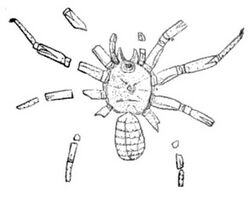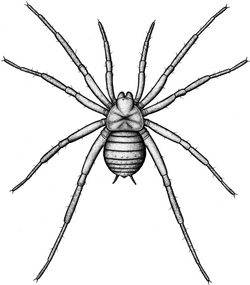Biology:Arthrolycosa
From HandWiki
Short description: Extinct genus of spiders
| Arthrolycosa Temporal range: Late Carboniferous to Late Permian
| |
|---|---|

| |
| Arthrolycosa antiqua, illustrated by C. E. Beecher | |

| |
| Reconstruction of Arthrolycosa wolterbeeki | |
| Scientific classification | |
| Missing taxonomy template (fix): | Araneae/? |
| Family: | †Arthrolycosidae |
| Genus: | †Arthrolycosa Harger, 1874 |
| Species | |
| |
Arthrolycosa (meaning wolf [spider] with joints) is an extinct genus of arachnids, possibly spiders, that lived about 300-250 million years ago.
Fossils have been found Mazon Creek USA, Piesberg in Germany and in the Kirov Oblast region, and the Kamensk-Shakhtinsky of Russia .[1][2][3][4]
A. antiqua is estimated to have a body length of about 2.17 cm[2] and may have preyed upon insects and other smaller animals that lived alongside them. A. wolterbeeki is the oldest spider known from Germany.[3]
External links & References
- ↑ Selden, Paul A.; Shcherbakov, Dmitry E.; Dunlop, Jason A.; Eskov, Kirill Yu. (2014-09-01). "Arachnids from the Carboniferous of Russia and Ukraine, and the Permian of Kazakhstan" (in en). Paläontologische Zeitschrift 88 (3): 297–307. doi:10.1007/s12542-013-0198-9. ISSN 1867-6812. https://doi.org/10.1007/s12542-013-0198-9.
- ↑ 2.0 2.1 Selden, P. A. (2021). "New spiders (Araneae: Mesothelae), from the Carboniferous of New Mexico and England, and a review of Paleozoic Araneae". New Mexico Museum of Natural History and Science Bulletin 84: 317–358. https://www.researchgate.net/publication/350955613.
- ↑ 3.0 3.1 Dunlop, Jason A. (2023-07-16). "The first Palaeozoic spider (Arachnida: Araneae) from Germany" (in en). PalZ. doi:10.1007/s12542-023-00657-7. ISSN 1867-6812. https://doi.org/10.1007/s12542-023-00657-7.
- ↑ Selden, P. A.; Eskov, K. Y. (2005). "First record of spiders from the Permian period (Araneae: Mesothelae)". Bulletin of the British Arachnological Society 13 (4): 111–116.
- Parker, Steve. Dinosaurus: the complete guide to dinosaurs. Firefly Books Inc, 2003. Pg. 75
- [1][|permanent dead link|dead link}}]
- [2][|permanent dead link|dead link}}]
Wikidata ☰ Q2864945 entry
 |

